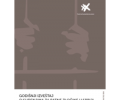Police Crackdown on Otpor – Serbia, 2 May to 24 September 2000
Otpor (Resistance) was initiated as a student movement in October 1998 by a group of Belgrade University students dissatisfied with the work of existing academic organizations and the failure of protests against Serbia’s repressive University Law.
The movement gained support at other universities in Serbia and its activists began publicly to put forward the demand for democratic changes summed up as ‘free and fair elections, a free and depoliticized University, and a free and independent media’. The movement spread rapidly to many cities and towns in Serbia. Comprising small groups of students at first, Otpor grew into a mass movement of political opponents to the government. Otpor’s symbol, a clenched fist, came to be recognized among the citizens as a symbol of personal courage and determination to install democratic values in Serbia. The Serbian government responded first by launching a media campaign portraying Otpor as an enemy organization, then by mounting a sweeping police action against its activists in May 2000. The election campaign in Serbia took place amid daily detention of Otpor activists.
Between the beginning of May and the middle of September 2000, the police arrested more than 2,000 Otpor activists, some 400 members of opposition political parties and about 100 activists of nongovernmental organizations (NGOs). An investigation by the Humanitarian Law Center (HLC), comprising interviews with victims of unlawful police actions and written evidence, shows that the Ministry of Internal Affairs (MUP) launched early in May a broad campaign against young people in Serbia in general and against Otpor activists in particular. The majority of detained people were up to twenty-five years of age, including some 200 between the ages of sixteen and eighteen. Some 300 Otpor activists were detained five or more times. On a number of separate occasions the police also detained thirty mothers who had taken part in Otpor actions. An analysis indicates that the police were employed in an organized and synchronized action with clear orders, instructions and objectives. Although the action was carried out throughout Serbia, its focus was clearly in Vojvodina. The uniform procedure employed in all the cases shows that the policemen acted on specific orders, deliberately and grossly violating the law and the Constitution. The determination with which members of the police force broke the law bore out their conviction that they would be exempted from any disciplinary or criminal action.
Full report Police Crackdown on Otpor – Serbia, 2 May to 24 September 2000






